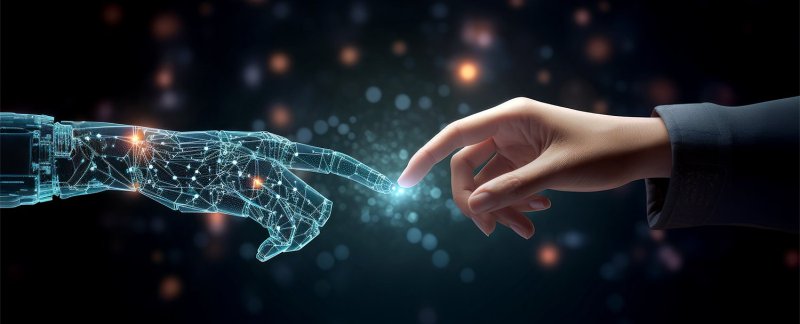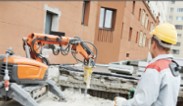
Think about the following questions.
1. What job would you ideally like to do?
2. Do you think this job could be affected by, or even done by, computers and robots in the future?
3. Which jobs do you think will be most affected? Which jobs will be least affected?
VOCABULARY PREVIEW
Match each New Academic Word List(NAWL) word with the correct definition.
- critique
- computation _____
- assembly _____
- unemployed _____
- psychologist _____
- optimum _____
- a. best or most suitable
- b. not having a job
- c. someone who studies the human mind and feelings
- d. the act of building something by putting parts together
- e. a report or statement that says what is good or bad about something
- f. the act or process of calculating an answer or amount by using a machine
THE FUTURE OF EMPLOYMENT

The way businesses operate and the way employees work is changing. It may seem that the COVID-19 pandemic caused changes to the way we use technology and the hours we work. However, in many cases, the pandemic only accelerated changes that were perhaps inevitable anyway.
Remote working via IT programs and applications allows employees to meet "face- to-face," no matter where they are. For obvious reasons, this function gained unprecedented importance during the pandemic. Tech companies like Zoom and Google innovated quickly to provide businesses with the features they needed. Companies look set to use remote working more in future, having realized that they can cut down on both expensive office space and costly business trips. Employees will see some financial benefit too, such as saving money on commutes1 and meals. However, it is still not clear that conferencing programs provide the optimum conditions for producing successful work. Furthermore, while many employees enjoy the freedom of working from home to begin with, this kind of isolation2 may have a negative effect on mental health in the long term.
The logistics3 of meetings weren't the only problem presented by the COVID-19 pandemic, of course. During the first year of the virus, it was estimated that in the US alone, up to twenty million people found themselves unemployed. To save jobs and maintain operations, companies had to be creative, which often meant two colleagues sharing one job. Job-shares like this were already increasingly common, and this upward trend will likely continue. For some workers, job-shares are ideal; they create a better work-life balance and allow time to raise children or care for elderly parents. Employers benefit, too; they can keep trained, trusted staff that they may otherwise have lost altogether. And staff with a good work-life balance are often happier and more productive. However, reduced hours may not be a welcome development for all employees. It usually means a reduced income, job-sharing partners need to compromise often, and shared responsibilities can lead to tension between colleagues. So, while hours are shorter, a shared job can still feel stressful.
Even before the pandemic, automation4 was a threat to many occupations as employers now have increasingly economical, efficient, non-human options. Some jobs, such as car assembly, were lost to robots long ago, but according to a report by the McKinsey Global Institute, 800 million further jobs across a variety of sectors could be lost to computers and robots by 2030. According to one study, telemarketers5 are at the greatest risk, with a ninety-nine percent chance of being replaced by computers. Jobs involving computation, such as accountancy6, are also at high risk. Those at lowest risk (only 0.3 percent) are psychologists, as their work involves dealing with subtle human emotions. Automation can actually result in new jobs as humans will be required to install, monitor, and maintain equipment. In fact, the World Economic Forum has suggested that overall, automation could create an extra twelve million jobs worldwide. With time though, intelligent systems and machines may well be able to take care of themselves.
To deal with a future of high unemployment, some governments are considering introducing a universal basic income (UBI). This would guarantee all citizens a wage to keep them from falling below the poverty line7. Supporters of UBI say that it would be cheaper than paying for the health and social-care problems that poverty creates. They also say that it could lead to increased birth rates in countries with aging populations. However, one common critique of UBI is that it may mean people are not incentivized8 to work at all.
In truth, employment will change in ways we cannot yet imagine. However, the COVID-19 pandemic gave us a glimpse9 of what the future of employment might look like. It seems likely that employees and businesses will need to be flexible. The increasing flexibility of machines, on the other hand, is guaranteed.
New Academic Word List
- commute 1 : n. a regular journey between work and home
- isolation 2 : n. the condition of being alone, especially when it makes you feel unhappy
- logistics 3 : n. the things that must be done to organize a complicated activity that involves many people
- automation 4 : n. the use of machines and computers that can operate without direct human control
- telemarketer 5 : n. a person who sells products or services by phone
- accountancy 6 : n. the job of being an accountant
- poverty line 7 : n. the minimum level of income needed to achieve a basic standard of living with food, clothing, and a place to live
- incentivize 8 : v. to make someone want to do something by offering them something
- glimpse9 : n. a brief or quick view or look
READING COMPREHENSION
A ‣ Mark each statement as true (T) or false (F) according to the reading.
- Companies are likely to move away from remote working in the future.
- True
- False
- Job-shares make some employees better at their jobs.
- True
- False
- People in job-sharing arrangements often make less money.
- True
- False
- Job openings for telemarketers are predicted to increase.
- True
- False
- UBI could lead to more people having kids, according to supporters.
- True
- False
B ‣ Choose the best answer according to the reading.
- What does the reading mainly say about the COVID-19 pandemic?
- a. It transformed the way businesses view their employees.
- b. It sped up existing trends in the way we work.
- c. It cost millions of jobs and will cost more in the future.
- d. It led to huge gains in efficiency and automation.
- Which is NOT stated about remote working?
- a. It allows employers to reduce their travel budgets.
- b. It could have negative psychological effects over time.
- c. It often seems appealing to employees at first.
- d. It appears to improve productivity and quality of work.
- The word they in paragraph 3 refers to _____.
- a. workers
- b. job-shares
- c. colleagues
- d. companies
- What is stated about automation?
- a. It has emerged as a problem in the last few years.
- b. It will mainly affect the manufacturing sector.
- c. It is unlikely to produce new jobs to replace those lost.
- d. It could lead to smart machines that maintain themselves.
C ‣ Look for the answers in the reading and write them on the lines.
- _____: the number of people who may have lost their jobs in America during the COVID-19 pandemic.
- _____: the year by which 800 million jobs may have been lost to automation
- _____: the percentage risk of psychologists losing their jobs to automation
SUMMARY
Fill in the blanks with the phrases in the box.
- equal work-life
- "face-to-face" meetings
- cause tension
- high unemployment
- keeping their staff
- smaller and cheaper
The way we work is changing: remote working, job-shares, and automation have all begun to have an impact and are likely to be used more in the future. Remote working allows workers to have 1 _____ when they are outside of the office. Companies are likely to keep using it because it means they can have 2 _____ offices. Job-shares have become popular because they allow companies to save money while 3 _____. Some employees actually like job-shares because they give them a more 4 _____ balance. However, others find that sharing responsibilities can 5 _____ with their work partners. Finally, automation is going to affect all industries, but will affect some more than others. Jobs that involve working with numbers are at risk of being taken by Al. Jobs which involve human emotions and interactions are relatively safe. Some governments are considering paying a UBI, which may help people if 6 _____ occurs in the future.
VOCABULARY PRACTICE
Fill in the blanks with the words in the box. Change the form if necessary.
- assembly
- critique
- optimum
- psychologist
- computation
- unemployed
- The writer's _____ of the film focused on its poorly written script.
- For _____ performance, athletes need to eat, drink, and sleep well.
- The famous _____ was interested in our dreams and what they mean.
- My cousin has been _____ for six months, but now he has a job interview.
- The _____ of a small airplane takes a team of six workers one month.
- The accounting program instantly performs every _____ you could ever need.
SUPPLEMENTAL READING
Automation in Construction

When one stops and thinks about it, there are few more important jobs than building homes for people to live in. However, in many developed countries, the construction industry does not pay well, and it struggles to attract young people. This means that there are not enough workers, a situation known as a labor shortage. In the coming years, automation and artificial intelligence (AI) look set to transform the industry. Some suggest that this will see even lower wages and less employment, but the opposite may be true.
Automation is likely to take over some practical building tasks such as laying bricks. In fact, Fastbrick Robotics is developing a robot, Hadrian X, which can lay up to 200 bricks in one hour, and CEO Mike Pivac says that Fastbrick's target is to increase that number to 1,000. This sounds like bad news for human bricklayers who might expect to lay 600 bricks in a whole day. However, humans would still be required to move robots like Hadrian X into position and set them up. Robots could also take on some of the more dangerous jobs on site, keeping humans safer.
And as 3D printing becomes cheaper and more efficient, it is likely to be used to produce many of the components needed for home-building, such as windows, doors, and fireplaces. 3D printers require skilled operators, and the components they produce will need to be transported and installed by humans. Finally, Al will improve the speed at which construction projects are planned, designed, and managed.
Faster construction means more projects and more profit, and may also mean more jobs across the industry as a whole. Those unable to afford homes also stand to benefit as they become cheaper to build and, therefore, to buy.
Fill in the blanks with information from the reading.
- Low wages mean there is a(n) _____ in the construction industry.
- Robots like Hadrian X may one day _____ 1,000 bricks an hour.
- 3D printing will soon be able to produce almost any _____ needed for a home.






















Leave a comment
Load more